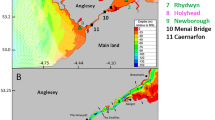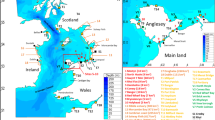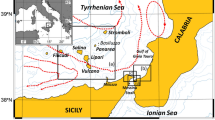Abstract
The king scallop (Pecten maximus) is one of the most important benthic species of the English Channel as it constitutes the first fishery in terms of landings in this area. To support strategies of spatial fishery management, we develop a high-resolution biophysical model to study scallop dispersal in two bays along the French coasts of the English Channel (i.e. the bay of Saint-Brieuc and the bay of Seine) and to quantify the relative roles of local hydrodynamic processes, temperature-dependent planktonic larval duration (PLD) and active swimming behaviour (SB). The two bays are chosen for three reasons: (1) the distribution of the scallop stocks in these areas is well known from annual scallop stock surveys, (2) these two bays harbour important fisheries and (3) scallops in these two areas present some differences in terms of reproductive cycle and spawning duration. The English Channel currents and temperature are simulated for 10 years (2000–2010) with the MARS-3D code and then used by the Lagrangian module of MARS-3D to model the transport. Results were analysed in terms of larval distribution at settlement and connectivity rates. While larval transport in the two bays depended both on the tidal residual circulation and the wind-induced currents, the relative role of these two hydrodynamic processes varied among bays. In the bay of Saint-Brieuc, the main patterns of larval dispersal were due to tides, the wind being only a source of variability in the extent of larval patch and the local retention rate. Conversely, in the bay of Seine, wind-induced currents altered both the direction and the extent of larval transport. The main effect of a variable PLD in relation to the thermal history of each larva was to reduce the spread of dispersal and consequently increase the local retention by about 10 % on average. Although swimming behaviour could influence larval dispersal during the first days of the PLD when larvae are mainly located in surface waters, it has a minor role on larval distribution at settlement and retention rates. The analysis of the connectivity between subpopulations within each bay allows identifying the main sources of larvae which depend on both the characteristics of local hydrodynamics and the spatial heterogeneity in the reproductive outputs.













Similar content being viewed by others
References
Ayata SD, Ellien C, Dumas F, Dubois S, Thiébaut E (2009) Modelling larval dispersal and settlement of the reef-building polychaete Sabellaria alveolata: role of hydrodynamic processes on the sustainability of biogenic reefs. Cont Shelf Res 29:1605–1623
Ayata SD, Lazure P, Thiébaut E (2010) How does the connectivity between populations mediate range limits of marine invertebrates? A case study of larval dispersal between the Bay of Biscay and the English Channel (North-East Atlantic). Prog Oceanogr 87:18–36
Bailly du Bois P, Dumas F (2005) Fast hydrodynamic model for medium- and long-term dispersion in seawater in the English Channel and southern North Sea, qualitative and quantitative validation by radionuclide tracers. Ocean Model 9:169–210
Beaumont AR, Barnes DA (1992) Aspects of veliger larval growth and byssus drifting of the spat of Pecten maximus and Aequipecten (Chlamys) opercularis. ICES J Mar Sci 49:417–423
Blanchard M (1997) Spead of the slipper limpet (Crepidula fornicata) in Europe. Current state and consequences. Sci Mar 61:109–118
Brand AR (2006) Scallop ecology: distribution and behaviour. In: Shumway S, Parsons J (eds) Developments in aquaculture and fisheries science, vol 35. Scallops: biology, ecology and aquaculture. Elsevier, Amsterdam, pp 651–744
Chauvaud L, Thouzeau G, Paulet YM (1998) Effects of environmental factors on the daily growth rate of Pecten maximus juveniles in the bay of Brest (France). J Exp Mar Biol Ecol 227:83–111
Chia FS, Buckland-Nicks J, Young CM (1984) Locomotion of marine invertebrate larvae: a review. Can J Zool 62:1205–1222
Comely CA (1972) Larval culture of the scallop Pecten maximus (L.). J Cons Int Explor Mer 34:365–378
Cowen RK, Sponaugle S (2009) Larval dispersal and marine population connectivity. Ann Rev Mar Sci 1:443–466
Cragg SM (1980) Swimming behaviour of the larvae of Pecten maximus (L.) (Bivalta). J Mar Biol 60:551–564
Cragg SM (2006) Development, physiology, behaviour and ecology of scallop larvae. In: Shumway S, Parsons J (eds) Developments in aquaculture and fisheries science, vol 35. Scallops: biology, ecology and aquaculture. Elsevier, Amsterdam, pp 45–122
Cugier P, Le Hir P (2002) Development of a 3D hydrodynamic model for coastal ecosystem modelling. Application to the plume of the Seine River (France). Estuar Coast Shelf Sci 55(5):673–695
Dawirs R (1985) Temperature and larval development of Carcinarus maenas (Decapoda) in the laboratory: predictions of larval dynamics. Mar Ecol Prog Ser 24:297–302
Dekshenieks MM, Hofmann EE, Klinck JM, Powell EN (1996) Modeling the vertical distribution of oyster larvae in response to environmental conditions. Mar Ecol Prog Ser 136:97–110
Edwards KP, Hare JA, Werner FE, Seim H (2007) Using 2-dimensional dispersal kernels to identify the dominant influences on larval dispersal on continental shelves. Mar Ecol Prog Ser 352:77–87
Ellien C, Thiébaut E, Dumas F, Salomon JC, Nival P (2004) A modelling study of the respective role of hydrodynamic processes and larval mortality on larval dispersal and recruitment of benthic invertebrates: example of Pectinaria koreni (Annelida : Polychaeta) in the bay of Seine (English Channel). J Plankton Res 26:117–132
Fifas S (1993) Analyse et modélisation des paramètres d’exploitation du stock de coquilles saint-jacques (Pecten maximus L.) en baie de Saint-Brieuc (Manche ouest, France). Thesis, 428 pp (http://archimer.ifremer.fr/doc/1993/rapport-1518.pdf)
Fifas S (2004) la coquille Saint Jacques en Bretagne, rapport ifremer, 14 pp. (http://envlit.ifremer.fr/content/download/64839/461476/version/1/file/20041207Coquille_Saint_Jacques_Bretagne.pdf)
Fogarty MJ, Botsford LW (2007) Population connectivity and spatial management of marine fisheries. Oceanography 20(3):112–123
Gilbert CS, Gentleman WC, Johnson CL, DiBacco C, Pringle JM, Chen C (2010) Modelling dispersal of sea scallop (Placopecten magellanicus) larvae on Georges Bank: the influence of depth-distribution, planktonic duration and spawning seasonality. Prog Oceanogr 87:37–48
Gruffydd LD, Beaumont AR (1972) A method of rearing Pecten maximus larvae in the laboratory. Mar Biol 15:350–355
Guitton J, Dintheer C, Dunn MR, Morizur Y and Tetard A (2003) Atlas des pêcheries de Manche. Ed. Ifremer, 216 pp
Hamon D and Blanchard M (1994) Etat de la prolifération de la crépidule (Crepidula fornicata) en baie de Saint-Brieuc. Rapport Ifremer, DEL 94–14, 29 pp
Herbert RJH, Willis J, Jones E, Ross K, Hübner R, Humphreys J, Jensen A, Baugh J (2011) Invasion in tidal zones on complex coastlines: modeling larvae of the non-native Manila clam, Ruditapes philippinarum, in the UK. J Biogeogr 39:585–599
Huret M, Petitgas P, Woillez M (2010) Dispernal kernels and their drivers captured with a hydrodynamic model and spatial indices: a case study on anchovy (Engraulis encrasicolus) early life stages in the Bay of Biscay. Prog Oceanogr 87:6–17
Jolly MT, Guyard P, Ellien C, Gentil F, Viard F, Thiébaut E, Jolivet D (2009) Population genetics and hydrodynamic modelling of larval dispersal dissociate contemporary patterns of connectivity from historical expansion into European shelf seas in the polychaete Pectinaria koreni (Malmgren). Limnol Oceanogr 54:2089–2106
Kaarvedt S, Aksnes DL, Egge JK (1987) Effect of light on the vertical distribution of Pecten maximus larvae. Mar Ecol Prog Ser 40:195–197
Largier JL (2003) Considerations in estimating larval dispersal distances from oceanographic data. Ecol Appl 13(1):S71–S89
Lazure P, Dumas F (2008) An external–internal mode coupling for a 3D hydrodynamical model for applications at regional scale (MARS). Adv Water Resour 31:233–250
Lazure P, Garnier V, Dumas F, Herry C, Chifflet M (2009) Development of a hydrodynamic model of the Bay of Biscay. Validation of hydrology. Cont Shelf Res 29:985–997
Le Boyer A, Cambon G, Daniault N, Herbette S, Le Cann B, Marié L (2009) Observations of the Ushant tidal front in September 2007. Cont Shelf Res 29:1026–1037
Le Pennec M, Paugam A, Le Pennec G (2003) The pelagic life of the pectinid Pecten maximus—a review. ICES J Mar Sci 60:211–223
Levin LA (2006) Recent progress in understanding larval dispersal: new directions and disgressions. Integr Comp Biol 46:282–297
Lubet P, Besnard J, Faveris R, Robbins I (1987) Physiologie de la reproduction de la coquille Saint Jacques (Pecten maximus L). Oceanis 13:265–290
Lyard F, Lefevre F, Letellier T, Francis O (2006) Modelling the global ocean tides: modern insights from fes2004. Ocean Dyn 56:394–415
Mann R, Campos BM, Luckenbach MW (1991) Swimming rate and responses of larvae of three mactrid bivalves to salinity discontinuities. Mar Ecol Prog Ser 68:257–269
Ménesguen A, Gohin F (2006) Observation and modeling of natural retention structures in the English Channel. J Mar Syst 63:244–256
Miller TJ (2007) Contribution of individual-based coupled physical–biological models to understanding recruitment in marine fish populations. Mar Ecol Prog Ser 347:127–138
Nicolle A, Garreau P, Liorzou B (2009) Modelling for anchovy recruitment studies in the Gulf of Lion (Western Mediterranean Sea). Ocean Dyn 59(6):953–968
North EW, Hood RR, Chao SY, Sanford LP (2006) Using a random displacement model to simulate turbulent particle motion in a baroclinic frontal zone: a new implementation scheme and model performance tests. J Mar Syst 63:365–380
North EW, Schlag Z, Hood RR, Li M, Zhong L, Gross T, Kennedy VS (2008) Vertical swimming behavior influences dispersal of simulated oyster larvae in a coupled particle-tracking and hydrodynamic model of Chesapeake Bay. Mar Ecol Prog Ser 359:99–115
O’Connor MI, Bruno JF, Gaines SD, Halpern BS, Lester SE, Kinlan BP, Weiss JM (2007) Temperature control of larval dispersal and the implications for marine ecology, evolution, and conservation. PNAS 104:1266–1271
Palumbi SR (2004) Marine reserves and ocean neighborhoods: the spatial scale of marine populations and their management. Annu Rev Environ Resour 29:31–68
Paugam A, Le Pennec M, Marhic A, Andre-Fontaine G (2003) Immunological in situ: determination of Pecten maximus larvae and their temporal distribution. J Mar Biol Assoc UK 83:1083–1093
Paulet YM, Fifas S (1989) Etude de la fécondité potentielle de la coquille Saint-Jacques Pecten maximus, en baie de Saint-Brieuc. Haliotis 19:275–285
Paulet YM, Lucas A, Gérard A (1988) Reproduction and larval development in two Pecten maximus (L.) population from Brittany. J Exp Mar Biol Ecol 119:145–156
Paulet YM, Ôorange G, Cochard IC, Le Pennec M (1992) Reproduction et recrutement chez Pecten maximus L. Ann Inst océanogr Paris 68(1–2):45–64
Pingree RD (1980) Physical oceanography of the Celtic Sea and English Channel. In: The north-west European shelf sea: sea bed and the sea in motion II. Phys and Chem Oceanogr and Phys Res. Elsevier Oceanography Series, 638 pp
Quéro JC and Vayne JJ (1998) Les fruits de la mer et plantes marines des pêches françaises. Ifremer, Delachaux and Niestlé (eds), 256 pp
Robert R, Gérard A (1999) Bivalve hatchery technology: the current situation for the Pacific oyster Crassostrea gigas and the scallop Pecten maximus in France. Aquat Living Resour 12(2):121–130
Salomon JC, Breton M (1993) An atlas of long-term currents in the Channel. Oceanol Acta 16(5–6):439–448
Sasaki R (1979) A report on study of scallop and oyster in the course of Japan/Scotland exchange research scholarship 1977/78. Published by Fisheries Division, Highlands and Islands Dev. Board, Scotland, 24 pp
Shanks AL, Grantham BA, Carr MH (2003) Propagule dispersal distance and the size and spacing of marine reserves. Ecol Appl 13:159–169
Smagorinsky J (1963) General circulation experiments with the primitive equation. I. The basic experiment. Mon Weather Rev 111:99–165
Thiébaut E, Lagadeuc Y, Olivier F, Dauvin JC, Retière C (1998) Do hydrodynamic factors affect the recruitment of marine invertebrates in a macrotidal area? The case study of Pectinaria koreni (Polychaeta) in the Bay of Seine (English Channel). Hydrobiol 375/376:165–176
Thouzeau G, Lehay D (1988) Variabilité spatio-temporelle de la distribution, de la croissance et de la survie des juvéniles de Pecten maximus (L.) issus des pontes 1985, en baie de Saint-Brieuc. Oceanol Acta 11:267–284
Thouzeau G, Chauvaud L, Grall J, Guérin L (2000) Rôle des interactions biotiques sur le devenir du pré-recrutement et la croissance de Pecten maximus (L.) en rade de Brest. CR Acad Sci Paris Sci vie/Life sci 323:815–825
Treml EA, Roberts JJ, Chao Y, Halpin PN, Possingham HP, Riginos C (2012) Reproductive output and duration of the pelagic larval stage determine seascape-wide connectivity of marine populations. Integr Comp Biol 52:525–537
Velo-Suarez L, Reguera B, Gonzales-Gil S, Lunven M, Lazure P, Nézan E, Gentien P (2010) Application of a 3D Lagrangian model to explain the decline of a Dynophysis acuminate bloom in the Bay of Biscay. J Mar Syst 83:242–252
Vignaud J (1994) Evaluation du stock de coquilles Saint Jacques de la Manche Est. Rapport Ifremer, 30 pp (http://archimer.ifremer.fr/doc/00076/18752/16323.pdf)
Vignaud J, Fifas S and Foucher E (2001) Les campagnes d’évaluation du stock de coquilles Saint-Jacques en Manche oriental: méthodologie et estimation des indices d’abondance. Rapport Ifremer 40 pp (http://archimer.ifremer.fr/doc/2001/rapport-6550.pdf)
Visser AW (1997) Using random walk models to simulate the vertical distribution of particles in a turbulent water column. Mar Ecol Prog Ser 158:275–281
Wang WX, Xu ZZ (1997) Larval swimming and postlarval drifting behavior in the infaunal bivalve Sinonovacula constricts. Mar Ecol Prog Ser 148:71–81
Acknowledgments
This research was supported by the ANR project COMANCHE (ANR-2010-STRA-010-02). The authors acknowledge the anonymous reviewers for the helpful and constructive comments.
Author information
Authors and Affiliations
Corresponding author
Additional information
Responsible Editor: Martin Verlaan
This article is part of the Topical Collection on the 16th biennial workshop of the Joint Numerical Sea Modelling Group (JONSMOD) in Brest, France 21-23 May 2012
Rights and permissions
About this article
Cite this article
Nicolle, A., Dumas, F., Foveau, A. et al. Modelling larval dispersal of the king scallop (Pecten maximus) in the English Channel: examples from the bay of Saint-Brieuc and the bay of Seine. Ocean Dynamics 63, 661–678 (2013). https://doi.org/10.1007/s10236-013-0617-1
Received:
Accepted:
Published:
Issue Date:
DOI: https://doi.org/10.1007/s10236-013-0617-1




